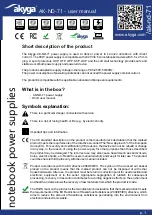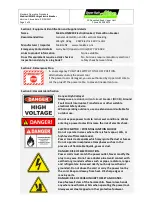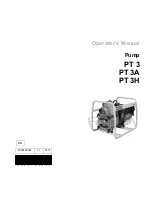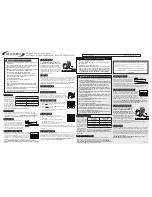
GENERAL & SPECIFIC SAFETY INSTRUCTIONS
CAUTION!
READ THESE WARNINGS BEFORE OPERATING
1. Recommended incoming air pressure is 65-120 PSI.
2. Maximum operating air pressure is 120 PSI.
If your air
compressor supplies air pressure in excess of 120 PSI, it is
absolutely necessary to reduce the incoming air pressure to less
than 120 PSI. Your air compressor should have a regulator which
controls the air pressure, if not have one installed.
3. Read and understand
the instruction manual before operating.
4. Always wear
a protective sandblasting hood and gloves when
loading, starting and sandblasting.
5. Never aim
the abrasive air stream at yourself or other persons.
6. Check and replace
all abrasive hoses and fittings on a regular
basis as these parts “wear” the same as the abrasive ceramic
nozzles.
7. Release all air pressure
from the tank before storage or routine
inspection and maintenance.
1. KNOW YOUR TOOL
Read and understand the owners manual and labels affixed to
the tool. Learn its application and limitations as well as its
specific potential hazards.
2. KEEP WORK AREA CLEAN.
Cluttered areas and benches invite accidents. Make sure the
floor is clean and not slippery due dust build-up.
3. AVOID DANGEROUS ENVIRONMENT.
Don’t use machinery in damp or wet locations or expose them to
rain. Keep work area well lit and provide adequate
surrounding work space.
4. KEEP CHILDREN AWAY.
All visitors should be kept a safe distance from work area.
5. MAKE WORKSHOP CHILD-PROOF.
Use padlocks, master switches or remove starter keys.
6. USE RIGHT TOOL.
Don’t force the tool or the attachment to do a job for which it was
not designed.
7. ALWAYS WEAR SAFETY GLASSES.
Always wear safety glasses (ANSI Z87.1). Everyday eyeglasses
only have impact resistant lenses, they are
NOT
safety glasses.
Also use a face or dust mask if operation is dusty.
8. DON’T OVERREACH.
Keep proper footing and balance at all times.
9. MAINTAIN TOOL WITH CARE.
Keep machine clean for best and safest performance. Follow
instructions for lubricating and changing accessories.
10. DISCONNECT TOOLS.
Before servicing, when changing accessories or attachments.
11. USE RECOMMENDED ACCESSORIES.
Consult the manual for recommended accessories. Follow the
instructions that accompany the accessories. The use of
improper accessories may cause hazards.
12. NEVER STAND ON TOOL.
Serious injury could occur if the tool tips over. Do not store
materials such that it is necessary to stand on the tool to reach
them.
13. CHECK DAMAGED PARTS.
Before further use of the tool, a guard or other parts that are
damaged should be carefully checked to ensure that they will
operate properly and perform their intended function. Check for
alignment of moving parts, breakage of parts, mounting, and
any other conditions that may affect its operation. A guard or
other parts that are damaged should be properly repaired or
replaced.
14. NEVER LEAVE MACHINE RUNNING
UNATTENDED.
Turn power ‘’OFF’’. Don’t leave any tool running until it comes
to a complete stop.
SPECIFIC SAFETY INSTRUCTIONS


























